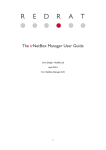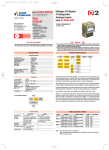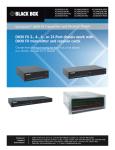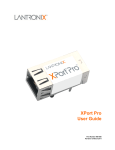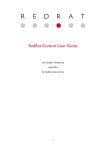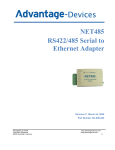Download The irNetBox Manager User Guide
Transcript
The irNetBox Manager User Guide Chris Dodge – RedRat Ltd March 2014 For IRNetBox Manager 3.05 -1- Contents 1. 2. 3. Introduction .......................................................................................................................................... 3 Initial Network Configuration ............................................................................................................... 3 Finding irNetBoxes ................................................................................................................................ 3 3.1 Device Information Fields ............................................................................................................. 4 3.1.1 ID Fields ................................................................................................................................ 4 3.1.2 IRNetBox Information .......................................................................................................... 4 3.1.3 Lookup .................................................................................................................................. 4 3.1.4 Network Information ........................................................................................................... 4 3.2 Testing The IRNetBox .................................................................................................................... 5 3.2.1 Reset XPort ........................................................................................................................... 5 3.2.2 Reset uC................................................................................................................................ 6 3.2.3 Blink ...................................................................................................................................... 6 3.2.4 IR Output Control ................................................................................................................. 6 3.2.5 IR Signal I/O .......................................................................................................................... 6 3.2.6 LED Display Pattern .............................................................................................................. 6 3.2.7 Firmware .............................................................................................................................. 6 3.2.8 Signal Capture Parameters ................................................................................................... 6 4. Configuring the irNetBox’s Network Interface ..................................................................................... 7 5. Setting the irNetBox’s IP Address via its MAC Address......................................................................... 7 6. Advanced Network Configuration Requirements ................................................................................. 8 -2- 1. Introduction The IRNetBox Manager is intended to help with the installation and setup of the RedRat irNetBox, providing basic testing of its functionality. It is not intended as an end-user application; once an irNetBox has been installed and configured, other software applications can then use it. 2. Initial Network Configuration The first task when installing the irNetBox is to configure its IP address. When delivered, it expects to use a dynamically allocated IP address using DHCP, however it can be assigned a static IP address. This is done using the Lantronix Device Installer, which is delivered on the CD with your unit, or can be downloaded from the Lantronix website at http://www.lantronix.com/. The basic configuration of using a dynamic IP address or providing a static IP address is adequate for most environments, but on networks with more restrictions it may be necessary for certain ports to be enabled in firewalls or filters. Section 5 provides more information on this. 3. Finding irNetBoxes Once the program has been started, use the Find menu item in the IRNetBoxes menu to initiate a search for devices on your network. This uses a UDP broadcast and waits for a response from devices which are then listed in the main panel. If UDP broadcasts are not permitted on your network, then you can add an irNetBox using its IP address from the IRNetBoxes -> Add (IP Address) menu item. If one of the devices is selected, some basic information about the device is displayed at the right of the application. -3- 3.1 Device Information Fields These fields show information primarily related to the network setup of the irNetBox and how it is discovered. 3.1.1 ID Fields These are informal device identification fields that can be changed to help identify individual devices. The values are stored on the PC on which the IRNetBox Manager is running, and so are not network wide, but are used by all RedRat software so will appear in other applications run on the same PC. Name A text name given to the device to help identification. This information is stored in the PCs registry, keyed on the MAC address. Description More detailed information about the use or location of the device. This information is stored in the PCs registry, keyed on the MAC address. 3.1.2 IRNetBox Information These fields show top-level information about the type of irNetBox: Type MK-I MK-II MK-III 3.1.3 Number of IR Outputs 16 16 16 IR Output Power Level Control LOW or HIGH power on port 1, otherwise LOW power only. LOW, MEDIUM or HIGH power on all outputs. Power controllable from 0 to 100 on all outputs. Lookup The method that software uses to find and so connect to the irNetBox, which can take two values: 1. BROADCAST: This is the default, using a UDP broadcast to initiate a response by the irNetBox which returns its IP address. 2. IP_ADDRESS: Setting the lookup method to this value gets the software to store the irNetBox’s current IP address and always uses this for connecting to the irNetBox. This value only really makes sense if the irNetBox has been set to use a static IP address. Note: If the IRNetBox Manager and other RedRat software cannot discover irNetBoxes via the broadcast mechanism, for example UDP is blocked on the network, then the devices must be assigned a static IP address to use. 3.1.4 Network Information Configuration Status Indicates whether the XPort network interface has been setup for correct operation within the irNetBox. This should always by OK, but there may be the occasional situation in which the configuration is lost, for example if the XPort’s firmware is updated, and in which case the entry for this irNetBox will be highlighted in red. The IRNetBox Manager can be used to reset the XPort’s configuration back to correct values from the IRNetBoxes -> Configure menu item – see section 7 for further information. -4- Gateway The IP address of the router for this network, however this is not generally used as the irNetBox does not attempt to make outgoing connections. IPAddress This is the address that has either been automatically assigned by DHCP or explicitly (statically) given to the irNetBox. MACAddress The globally unique number of this Ethernet interface, and so it is also used as the key for storing additional information on the host PC. Subnet Mask Indicates the network segment or subnet/network class on which the irNetBox resides. XPort Type Gives the version of the XPort that is used in the irNetBox. 3.2 Testing The IRNetBox By double clicking on the name of the irNetBox, or selecting the required name from the Control Device menu item (under IRNetBoxes), a control panel for the device will be shown. The left hand side of the panel allows control of various aspects of the device. The purpose of this dialog is to validate that we have network communication with the device, to help install the stick-on emitters and ensure that the A/V equipment under control responds correctly. 3.2.1 Reset XPort This will reset the XPort, however is generally not needed as configuration changes to the XPort cause it to be reset anyway. -5- 3.2.2 Reset uC On the MK-III irNetBox, this resets the irNetBox’s IR input/output microcontroller (uC). Previous irNetBox versions did not support this feature. This should not normally need to be used. 3.2.3 Blink Causes all IR output indication LEDs on the front panel to flash, and is a good method of validating communication with the irNetBox. 3.2.4 IR Output Control This area allows testing and validation of the IR outputs, for example to check that output number 4 (staring from top left) is actually wired up to a particular device. To enable/disable an output, click on the red circle, and a lighter colour red will indicate that it has been enabled. The red LEDs on the irNetBox front panel should also reflect the same state as the display. All On: Enables all IR outputs. Reset: Puts the IR outputs into the reset state, i.e. all off. 3.2.5 IR Signal I/O To test signal output, use this to learn/capture an IR signal from the remote control. The learning IR detector is placed centrally in the front panel, and the remote should be placed about 10cm from the detector during learning. The application stores a single signal only - for full signal database management please use the RedRat signal DB utility. Learn Signal: Starts a signal input/learning operation. Output Signal: This will output the signal captured in the previous step through all IR outputs that have been enabled. Repeat Start: This starts a sequence of repeatedly outputting the IR signal through each output, which can be useful when testing irNetBox installations. For example, when placing a stick-on IR emitter, it can be moved around while the IR signal is being output until the optimum position is found. Repeat Stop: Stops the sequence initiated by the “Repeat Start” button. 3.2.6 LED Display Pattern This outputs a repeating display pattern on the red LEDs and can be used to validate operation and reliable communication with the device. 3.2.7 Firmware This shows the version of the firmware running on the irNetBox. 3.2.8 Signal Capture Parameters These parameters are used to adjust the exact behaviour of signal input. In cases of difficulty when capturing a signal, these values can be adjusted to improve signal learning, however this is not generally needed. The parameters are all returned to their default value on microcontroller reset. End of Signal Timeout: The value for the IR dead period at the end of a signal used by the irNetBox to determine the end of a signal. Units are in ms. -6- Length Delta: The irNetBox uses a set of lengths as the alphabet used to represent most IR signals. Due to the approximate nature of IR signal data, two supposedly identical values will be slightly different, so this attribute controls the maximum variation allowed between values for them to be considered the same. Max. Lengths: The maximum number of length values (the signal alphabet) that can be used in a single signal. Min. Pause Size: This value is not used during signal learning. No. Periods For Mod. Freq: The carrier or modulation frequency is measured during the first pulse of the IR signal. The larger the number of periods used to measure, the more accurate the result is likely to be, however some signals have short initial pulses, so in some case it may be necessary for applications to adjust this value. Signal Memory Size: The number of bytes allocated to hold the IR signal data. 4. Configuring the irNetBox’s Network Interface The irNetBox’s network interface uses the XPort from Lantronix, and is specifically configured for operation in the irNetBox. There are also minor configuration differences between the different irNetBox versions. If the XPort loses its setup or is completely reset, the irNetBox will not be able to function, so the XPort will need to be re-configued. This is done from the IRNetBoxes Configure menu item and care should be taken when doing this to ensure that the correct irNetBox version is set. By default, the configuration steps will not allow changing the irNetBox type, but this can be overridden in the options dialog (from the File Options menu item). Another issue that can happen if the XPort loses configuration information is that RedRat applications and software will not think it is an irNetBox, so will not list it. In this situation, the option can be selected to “Accept responses from hardware not explicitly labeled as a RedRat device…”. Note: Care must be taken with this as there may be other devices on the network using XPorts and so these should not be configured as irNetBoxes! So only use this option if you recognize the IP/Mac address as an irNetBox. 5. Setting the irNetBox’s IP Address via its MAC Address New in V3.05 of IRNetBox Manager. If you find that you can’t communicate with an irNetBox because the IP address is not correct for your network, for example it has been moved from one network to another, then this gives a mechanism for resetting its IP address. This can be found on the IRNetBoxes -> Set IP via MAC Address menu item. A change IP address instruction is sent to the XPort via UDP broadcast, but only the XPort with the correct MAC address will respond to it. The information you need to use this is: 1. The last two bytes of the device’s MAC address. This can be found on the back of the irNetBox, or on older units, by removing the lid and looking at the number on the XPort network module. 2. The IP address that you would like to give the irNetBox so that it will work on your network. You can also give it the address 0.0.0.0 which will instruct the unit to use a dynamic IP address from a DHCP server. -7- Once you have performed this operation, then you need to wait for about 10 seconds while the XPort restarts. Following this, use the IRNetBoxes -> Find menu item to look for the units again. 6. Advanced Network Configuration Requirements On restricted networks, or if attempting to use an irNetBox from behind a firewall, the following ports need to be opened: • TCP 10001 (0x2711). • UDP 30718 (0x77FE). Newer versions of RedRat software can use TCP 30718 instead. • TCP 30704 (0x77F0). -8-








